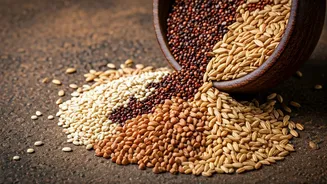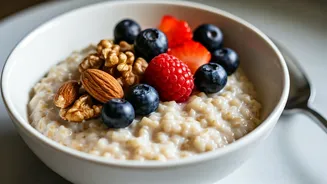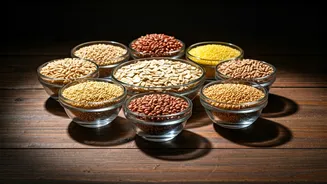Introduction to Grains
Grains are fundamental to many diets around the globe, and for people with diabetes, the choice of grain plays a crucial role in managing blood glucose
levels. Not all grains are created equal, and some can cause significant spikes in blood sugar, while others offer a slower, more controlled release of glucose. This difference stems from their varying glycemic index (GI), a measure of how quickly a food raises blood sugar. When considering grains for a diabetes-friendly diet, the goal is to choose those with a lower GI, which allows for better blood sugar control and reduced risk of complications. The right grain selections can greatly enhance the overall effectiveness of a diabetes management plan, complementing other strategies such as medication and regular exercise.
Oats: The Powerhouse
Oats, especially those in the form of steel-cut or rolled oats, are an excellent choice due to their high fiber content, particularly soluble fiber known as beta-glucan. This type of fiber helps to slow down the absorption of sugar, preventing sudden blood sugar spikes after meals. Moreover, oats have a relatively low GI, making them a safe and effective option for individuals with diabetes. Regular consumption of oats has also been linked to improved cholesterol levels, which is a significant benefit given that individuals with diabetes are often at a higher risk of heart-related issues. Oats can be prepared in many ways, from simple oatmeal for breakfast to being incorporated into baked goods or savory dishes.
Quinoa: A Complete Protein
Quinoa stands out as a complete protein source, meaning it contains all nine essential amino acids that the body needs but cannot produce on its own. It's also a good source of fiber, which aids in blood sugar control, and has a lower GI than many other grains. Quinoa's versatility makes it an excellent addition to any diabetic meal plan. It can be used as a substitute for rice, in salads, or as a base for various dishes. Beyond its protein and fiber benefits, quinoa provides essential minerals like magnesium and iron, contributing to overall health and well-being. It is also gluten-free, making it suitable for those with celiac disease or gluten sensitivity.
Barley: Fiber-Rich Choice
Barley is rich in soluble fiber, which is crucial for managing blood sugar levels. It helps to slow down the digestion and absorption of carbohydrates, preventing sharp increases in blood glucose. Barley also offers a range of vitamins and minerals, adding to its nutritional profile. When choosing barley, opt for the whole-grain variety, such as hulled barley, which retains more of the grain's nutrients and fiber. Barley can be included in soups, stews, salads, or as a side dish. The fiber in barley not only aids in blood sugar control but also supports digestive health, making it a beneficial choice for those with diabetes.
Brown Rice: A Staple
Brown rice is a whole grain that offers more fiber and nutrients than its refined counterpart, white rice. The fiber in brown rice slows down the digestion of carbohydrates, preventing rapid spikes in blood sugar. It also provides essential nutrients like magnesium and selenium, which are important for overall health. Brown rice has a moderate GI, making it a suitable choice for individuals with diabetes when consumed in moderation. It can be a versatile base for many meals, from curries to stir-fries. Opting for brown rice over white rice is a simple dietary change that can lead to improved blood sugar control and overall well-being.
Bulgur: Quick and Nutritious
Bulgur, a whole-grain wheat product, is pre-cooked and dried, which makes it quicker to prepare than some other whole grains. It is a good source of fiber and has a relatively low GI, making it a beneficial option for managing blood sugar levels. Bulgur is often used in Middle Eastern dishes like tabbouleh but can also be added to salads, soups, and stews. Its high fiber content contributes to satiety, which can help control appetite and prevent overeating. Bulgur provides a good source of iron, making it an excellent choice for those looking to boost their nutritional intake while managing diabetes.
Millet: Gluten-Free Option
Millet is a gluten-free grain that is easy to digest and rich in fiber. It has a low GI, which means it causes a slower rise in blood sugar levels. Millet is also a good source of magnesium, which plays a role in insulin sensitivity. This grain can be cooked as a porridge, used as a base for salads, or added to soups. Millet is becoming increasingly popular in the Indian diet as a healthy alternative to rice and other grains. Its nutritional profile, combined with its ability to aid in blood sugar control, makes it a valuable addition to a diabetes-friendly meal plan.
Buckwheat: Not Wheat
Despite its name, buckwheat is not related to wheat and is actually a seed. It is a gluten-free grain that offers a good source of fiber and has a low GI, making it a beneficial choice for individuals with diabetes. Buckwheat provides essential nutrients, including magnesium and manganese. It can be used to make porridge, pancakes, or added to various dishes. Buckwheat is known for its nutty flavor and versatility. Its high fiber content helps to slow down the absorption of glucose, contributing to stable blood sugar levels. Including buckwheat in your diet can be a delicious and healthful way to support diabetes management.
Amaranth: Ancient Grain
Amaranth, another gluten-free grain, is a complete protein and a good source of fiber. It has a low GI and contains essential nutrients like iron and magnesium. Amaranth can be used in various ways, such as in porridge, salads, or as a thickening agent in soups and stews. It's a versatile grain that can easily be incorporated into diverse culinary preparations. The combination of high protein, fiber, and low GI makes amaranth an excellent choice for individuals aiming to manage blood sugar and improve overall health. Its unique nutritional profile sets it apart as a valuable addition to a diabetes-friendly diet.
Whole Wheat Pasta: Moderation
Whole wheat pasta, unlike refined pasta, retains the bran and germ, which are rich in fiber. This makes it a better choice than white pasta for individuals with diabetes, as it leads to a slower rise in blood sugar. Whole wheat pasta provides essential nutrients and offers a more sustained release of energy. Portion control is essential. Pair it with non-starchy vegetables and lean protein for a balanced meal. Choosing whole wheat pasta over refined varieties is a small but impactful change that can assist in blood sugar control and promote better health. Always monitor your blood sugar after eating pasta to gauge its impact.
Final Thoughts and Tips
Incorporating these 10 diabetes-friendly grains into your diet can significantly aid in managing blood sugar levels and improving overall health. Remember to consider portion sizes, as even healthy grains can impact blood sugar if consumed in excess. Combine these grains with a balanced diet rich in non-starchy vegetables, lean proteins, and healthy fats. Regular monitoring of blood sugar, in conjunction with lifestyle adjustments, is key to successful diabetes management. Consulting with a healthcare provider or a registered dietitian can provide personalized guidance and ensure the best approach for individual needs. Making informed dietary choices is an empowering step towards a healthier life.













